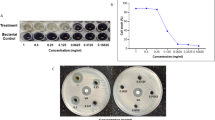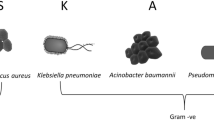Abstract
Emerging resistance of microbial cells towards antibiotics or disinfectants leads to an increase of nosocomial diseases, often biofilm related, and gives rise to the need for research for new antimicrobial substances. These studies are often focused on substances that are able to support the efficacy of currently used antimicrobials, reduce their required dosage and reduce the probability of resistance development. This work brings new insights into the in vitro interaction of rhamnolipid biosurfactant and amphotericin B against Candida sp. or Trichosporon sp.. The minimum inhibitory concentrations and fractional inhibitory concentration indexes for both planktonic and biofilm cells were determined by the chequerboard microdilution method. Combination effect of rhamnolipid and amphotericin B was observed for both yeasts. Synergy, defined as a fractional inhibitory concentration (FICi) index of 0.50, was observed in both planktonic and biofilm cells of Trichosporon cutaneum. For C. parapsilosis, synergistic effect (FICi 0.5) was observed for planktonic cells, and additive effect (FICi 0.8) for biofilm cells. The influence of concentrations established as FICi on biofilm formation and susceptibility was studied by light microscopy. The highest inhibition (90% colonized area reduction) of initial adhesion of C. parapsilosis was observed when biofilm FIC was applied.




Similar content being viewed by others
Abbreviations
- MICP :
-
Minimum inhibitory concentration for planktonic cells
- MICB :
-
Minimum inhibitory concentration for adherent cells
- FICP :
-
Fractional inhibitory concentration for planktonic cells
- FICB :
-
Fractional inhibitory concentration for adherent cells
- FIC:
-
Fractional inhibitory concentration
- FICi:
-
Fractional inhibitory concentration index
References
Al-Fattani MA, Douglas LJ (2006) Biofilm matrix of Candida albicans and Candida tropicalis: chemical composition and role in drug resistance. J Med Microbiol 55(8):999–1008. doi:10.1099/jmm.0.46569-0
Andrews JM (2001) Determination of minimum inhibitory concentrations. J Antimicrob Chemother 48:5–16. doi:10.1093/jac/48.suppl_1.5
Banat IM, De Rienzo MAD, Quinn GA (2014) Microbial biofilms: biosurfactants as antibiofilm agents. Appl Microbiol Biotechnol 98(24):9915–9929. doi:10.1007/s00253-014-6169-6
Barchiesi F, Di Francesco LF, Compagnucci P, Arzeni D, Giacometti A, Scalise G (1998) In-vitro interaction of terbinafine with amphotericin B, fluconazole and itraconazole against clinical isolates of Candida albicans. J Antimicrob Chemother 41(1):59–65. doi:10.1093/Jac/41.1.59
Cordeiro RD, Serpa R, Alexandre CFU, Marques FJD, de Melo CVS, Franco JD, Evangelista AJD, de Camargo ZF, Brilhante RSN, Rocha MFG, Moreira JLB, Bandeira TDPG, Sidrim JJC (2015) Trichosporon inkin biofilms produce extracellular proteases and exhibit resistance to antifungals. J Med Microbiol 64:1277–1286. doi:10.1099/jmm.0.000159
d’Enfert C (2006) Biofilms and their role in the resistance of pathogenic Candida to antifungal agents. Curr Drug Targets 7(4):465–470. doi:10.2174/138945006776359458
Di Bonaventura G, Pompilio A, Picciani C, Iezzi M, D’Antonio D, Piccolomini R (2006) Biofilm formation by the emerging fungal pathogen Trichosporon asahii: development, architecture, and antifungal resistance. Antimicrob Agents Chemother 50(10):3269–3276. doi:10.1128/Aac.00556-06
Donlan RM, Costerton JW (2002) Biofilms: survival mechanisms of clinically relevant microorganisms. Clin Microbiol Rev 15(2):167–193. doi:10.1128/Cmr.15.2.167-193.2002
Franzot SP, Casadevall A (1997) Pneumocandin L-743,872 enhances the activities of amphotericin B and fluconazole against Cryptococcus neoformans in vitro. Antimicrob Agents Chemother 41(2):331–336
Gilbert P, Maira-Litran T, McBain AJ, Rickard AH, Whyte FW (2002) The physiology and collective recalcitrance of microbial biofilm communities. Adv Microb Physiol 46:203–256. doi:10.1016/S0065-2911(02)46005-5
Girmenia C, Venditti M, Martino P (2003) Fluconazole in combination with flucytosine in the treatment of fluconazole-resistant Candida infections. Diagn Microbiol Infect Dis 46(3):227–231. doi:10.1016/s0732-8893(03)00064-6
Guo N, Wu XP, Yu L, Liu JB, Meng RZ, Jin J, Lu HJ, Wang XL, Yan SH, Deng XM (2009) In vitro and in vivo interactions between fluconazole and allicin against clinical isolates of fluconazole-resistant Candida albicans determined by alternative methods. FEMS Immunol Med Microbiol 58(2):193–201. doi:10.1111/j.1574-695X.2009.00620.x
Hoskova M, Jezdik R, Schreiberova O, Chudoba J, Sir M, Cejkova A, Masak J, Jirku V, Rezanka T (2015) Structural and physiochemical characterization of rhamnolipids produced by Acinetobacter calcoaceticus, Enterobacter asburiae and Pseudomonas aeruginosa in single strain and mixed cultures. J Biotechnol 193:45–51. doi:10.1016/j.jbiotec.2014.11.014
Hyldgaard M, Mygind T, Meyer RL (2012) Essential oils in food preservation: mode of action, synergies, and interactions with food matrix components. Front Microbiol 3:12. doi:10.3389/fmicb.2012.00012
Jiang LF, Shen C, Long XW, Zhang GL, Meng Q (2014) Rhamnolipids elicit the same cytotoxic sensitivity between cancer cell and normal cell by reducing surface tension of culture medium. Appl Microbiol Biotechnol 98(24):10187–10196. doi:10.1007/s00253-014-6065-0
Karashima R, Yamakami Y, Yamagata E, Tokimatsu I, Hiramatsu K, Nasu M (2002) Increased release of glucuronoxylomannan antigen and induced phenotypic changes in Trichosporon asahii by repeated passage in mice. J Med Microbiol 51(5):423–432. doi:10.1099/0022-1317-51-5-423
Kontoyiannis DP, Lewis RE (2004) Toward more effective antifungal therapy: the prospects of combination therapy. Br J Haematol 126(2):165–175. doi:10.1111/j.1365-2141.2004.05007.x
Kumar SN, Aravind SR, Sreelekha TT, Jacob J, Kumar BS (2015) Asarones from Acorus calamus in combination with azoles and amphotericin B: a novel synergistic combination to compete against human pathogenic Candida species in vitro. Appl Biochem Biotechnol 175(8):3683–3695. doi:10.1007/s12010-015-1537-y
Kvasnickova E, Matatkova O, Cejkova A, Masak J (2015) Evaluation of baicalein, chitosan and usnic acid effect on Candida parapsilosis and Candida krusei biofilm using a Cellavista device. J Microbiol Methods 118:106–112. doi:10.1016/j.mimet.2015.09.002
Lara HH, Romero-Urbina DG, Pierce C, Lopez-Ribot JL, Arellano-Jimenez MJ, Jose-Yacaman M (2015) Effect of silver nanoparticles on Candida albicans biofilms: an ultrastructural study. J Nanobiotechnol 13:91. doi:10.1186/s12951-015-0147-8
Leung CY, Chan YC, Samaranayake LP, Seneviratne CJ (2012) Biocide resistance of Candida and Escherichia coli biofilms is associated with higher antioxidative capacities. J Hosp Infect 81(2):79–86. doi:10.1016/j.jhin.2011.09.014
Li H, Lu Q, Wan Z, Zhang J (2010) In vitro combined activity of amphotericin B, caspofungin and voriconazole against clinical isolates of Trichosporon asahii. Int J Antimicrob Agents 35(6):550–552. doi:10.1016/j.ijantimicag.2010.01.013
Liao Y, Zhao H, Lu XL, Yang ST, Zhou JF, Yang RY (2015) Efficacy of ethanol against Trichosporon asahii biofilm in vitro. Med Mycol 53(4):396–404. doi:10.1093/mmy/myv006
Martinez LR, Casadevall A (2007) Cryptococcus neoformans biofilm formation depends on surface support and carbon source and reduces fungal cell susceptibility to heat, cold, and UV light. Appl Environ Microbiol 73(14):4592–4601. doi:10.1128/AEM.02506-06
Monteiro AS, Miranda TT, Lula I, Denadai AM, Sinisterra RD, Santoro MM, Santos VL (2011) Inhibition of Candida albicans CC biofilms formation in polystyrene plate surfaces by biosurfactant produced by Trichosporon montevideense CLOA72. Colloid Surf B Biointerfaces 84(2):467–476. doi:10.1016/j.colsurfb.2011.02.001
Nikolaev YA, Plakunov VK (2007) Biofilm—”City of microbes” or an analogue of multicellular organisms? Microbiology 76(2):125–138. doi:10.1134/S0026261707020014
Nunes JM, Bizerra FC, Ferreira RC, Colombo AL (2013) Molecular identification, antifungal susceptibility profile, and biofilm formation of clinical and environmental Rhodotorula species isolates. Antimicrob Agents Chemother 57(1):382–389. doi:10.1128/AAC.01647-12
Pires RH, Montanari LB, Martins CH, Zaia JE, Almeida AM, Matsumoto MT, Mendes-Giannini MJ (2011) Anticandidal efficacy of cinnamon oil against planktonic and biofilm cultures of Candida parapsilosis and Candida orthopsilosis. Mycopathologia 172(6):453–464. doi:10.1007/s11046-011-9448-0
Quan H, Cao YY, Xu Z, Zhao JX, Gao PH, Qin XF, Jiang YY (2006) Potent in vitro synergism of fluconazole and berberine chloride against clinical isolates of Candida albicans resistant to fluconazole. Antimicrob Agents Chemother 50(3):1096–1099. doi:10.1128/AAC.50.3.1096-1099.2006
Rezanka T, Kolouchova I, Cejkova A, Sigler K (2012) Natural products: strategic tools for modulation of biofilm formation. In: Atta-ur-Rahman F (ed) Studies in natural products chemistry, vol 38. Elsevier, Amsterdam, pp 269–303
Robbins N, Uppuluri P, Nett J, Rajendran R, Ramage G, Lopez-Ribot JL, Andes D, Cowen LE (2011) Hsp90 governs dispersion and drug resistance of fungal biofilms. PLoS Pathog 7(9):e1002257. doi:10.1371/journal.ppat.1002257
Rodrigues L, Banat IM, Teixeira J, Oliveira R (2006) Biosurfactants: potential applications in medicine. J Antimicrob Chemother 57(4):609–618. doi:10.1093/Jac/Dkl024
Rosato A, Vitali C, Gallo D, Balenzano L, Mallamaci R (2008) The inhibition of Candida species by selected essential oils and their synergism with amphotericin B. Phytomedicine 15(8):635–638. doi:10.1016/j.phymed.2008.05.001
Samadi N, Abadian N, Ahmadkhaniha R, Amini F, Dalili D, Rastkari N, Safaripour E, Mohseni FA (2012) Structural characterization and surface activities of biogenic rhamnolipid surfactants from Pseudomonas aeruginosa isolate MN1 and synergistic effects against methicillin-resistant Staphylococcus aureus. Folia Microbiol 57(6):501–508. doi:10.1007/s12223-012-0164-z
Sanglard D, Odds FC (2002) Resistance of Candida species to antifungal agents: molecular mechanisms and clinical consequences. Lancet Infect Dis 2(2):73–85. doi:10.1016/S1473-3099(02)00181-0
Sardi JCO, Scorzoni L, Bernardi T, Fusco-Almeida AM, Giannini MJSM (2013) Candida species: current epidemiology, pathogenicity, biofilm formation, natural antifungal products and new therapeutic options. J Med Microbiol 62:10–24. doi:10.1099/Jmm.0.045054-0
Serena C, Pastor FJ, Gilgado F, Mayayo E, Guarro J (2005) Efficacy of micafungin in combination with other drugs in a murine model of disseminated trichosporonosis. Antimicrob Agents Chemother 49(2):497–502. doi:10.1128/Aac.49.2.497-502.2005
Sharma M, Manoharlal R, Negi AS, Prasad R (2010) Synergistic anticandidal activity of pure polyphenol curcumin I in combination with azoles and polyenes generates reactive oxygen species leading to apoptosis. FEMS Yeast Res 10(5):570–578. doi:10.1111/j.1567-1364.2010.00637.x
Sharma G, Raturi K, Dang S, Gupta S, Gabrani R (2014) Combinatorial antimicrobial effect of curcumin with selected phytochemicals on Staphylococcus epidermidis. J Asian Nat Prod Res 16(5):535–541. doi:10.1080/10286020.2014.911289
Silva S, Negri M, Henriques M, Oliveira R, Williams DW, Azeredo J (2012) Candida glabrata, Candida parapsilosis and Candida tropicalis: biology, epidemiology, pathogenicity and antifungal resistance. FEMS Microbiol Rev 36(2):288–305. doi:10.1111/j.1574-6976.2011.00278.x
Singh N, Shetye GS, Zheng H, Sun J, Luk YY (2016) Chemical signals of synthetic disaccharide derivatives dominate rhamnolipids at controlling multiple bacterial activities. ChemBioChem 17(1):102–111. doi:10.1002/cbic.201500396
Sun W, Su J, Xu S, Yan D (2012) Trichosporon asahii causing nosocomial urinary tract infections in intensive care unit patients: genotypes, virulence factors and antifungal susceptibility testing. J Med Microbiol 61(Pt 12):1750–1757. doi:10.1099/jmm.0.049817-0
Sweeney MT, Zurenko GE (2003) In vitro activities of linezolid combined with other antimicrobial agents against staphylococci, enterococci, pneumococci, and selected gram-negative organisms. Antimicrob Agents Chemother 47(6):1902–1906. doi:10.1128/Aac.47.6.1902-1906.2003
Taha MO, Al-Bakri AG, Zalloum WA (2006) Discovery of potent inhibitors of pseudomonal quorum sensing via pharmacophore modeling and in silico screening. Bioorg Med Chem Lett 16(22):5902–5906. doi:10.1016/j.bmcl.2006.08.069
Vediyappan G, Rossignol T, d’Enfert C (2010) Interaction of Candida albicans biofilms with antifungals: transcriptional response and binding of antifungals to beta-glucans. Antimicrob Agents Chemother 54(5):2096–2111. doi:10.1128/Aac.01638-09
Wei GX, Xu X, Wu CD (2011) In vitro synergism between berberine and miconazole against planktonic and biofilm Candida cultures. Arch Oral Biol 56(6):565–572. doi:10.1016/j.archoralbio.2010.11.021
Yu VL, Zuravleff JJ, Bornholm J, Archer G (1984) In vitro synergy testing of triple antibiotic combinations against Staphylococcus epidermidis isolates from patients with endocarditis. J Antimicrob Chemother 14(4):359–366. doi:10.1093/Jac/14.4.359
Zhou Y, Wang G, Li Y, Liu Y, Song Y, Zheng W, Zhang N, Hu X, Yan S, Jia J (2012) In vitro interactions between aspirin and amphotericin B against planktonic cells and biofilm cells of Candida albicans and C. parapsilosis. Antimicrob Agents Chemother 56(6):3250–3260. doi:10.1128/AAC.06082-11
Ziccardi M, Souza LO, Gandra RM, Galdino AC, Baptista AR, Nunes AP, Ribeiro MA, Branquinha MH, Santos AL (2015) Candida parapsilosis (sensu lato) isolated from hospitals located in the Southeast of Brazil: species distribution, antifungal susceptibility and virulence attributes. Int J Med Microbiol 305(8):848–859. doi:10.1016/j.ijmm.2015.08.003
Acknowledgements
This work was supported by the Czech Science Foundation (GA CR) [14-23597S] and by the “Operational Programme Prague—Competitiveness” [CZ.2.16/3.1.00/24503] and the “National Program of Sustainability I”—NPU I (LO1601-No.: MSMT-43760/2015).
Author information
Authors and Affiliations
Corresponding author
Rights and permissions
About this article
Cite this article
Maťátková, O., Kolouchová, I., Kvasničková, E. et al. Synergistic action of amphotericin B and rhamnolipid in combination on Candida parapsilosis and Trichosporon cutaneum . Chem. Pap. 71, 1471–1480 (2017). https://doi.org/10.1007/s11696-017-0141-8
Received:
Accepted:
Published:
Issue Date:
DOI: https://doi.org/10.1007/s11696-017-0141-8




